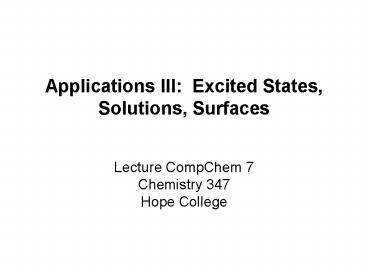Applications III: Excited States, Solutions, Surfaces - PowerPoint PPT Presentation
Applications III: Excited States, Solutions, Surfaces
Applications III: Excited States, Solutions, Surfaces Lecture CompChem 7 Chemistry 347 Hope College Excited State Methods Difficult to compute,as methods tend to find ... – PowerPoint PPT presentation
Title: Applications III: Excited States, Solutions, Surfaces
1
Applications III Excited States, Solutions,
Surfaces
- Lecture CompChem 7Chemistry 347Hope College
2
Excited State Methods
- Difficult to compute,as methods tend to find the
ground state - ZINDO semi-empirical
- CIS (CI-Singles) fast, robust, qualitative
- TD (Time Dependent) fast
- CASSCF (Complete Active Space SCF) slow,
tricky, more accurate (full CI of a subset of
orbitals)
3
CIS
- Promote a single electron electron from occupied
to unoccupied orbitals - Wavefunctions are built up from these interacting
electron configurations - Lowest energy wavefunction is the ground state
higher energy wavefunctions are excited states - Energy differences between states correspond to
electronic transitions in the UV-Vis spectrum
4
Solution Methods
- Default calculations are gas phase (isolated
molecule) - Onsager (Dipole and spherical cavity)
- PCM (Polarized Continuum Model)
- atomic spheres
- isodensity surface
- SCF isodensity surface
- COSMO (Conductor-like Screening Model)
- can compute energy derivatives
5
Solution Calculations
- Solvent is characterized by their dielectric
constant - Water78.4, acetonitrile35.4, cycloheaxane2.0
- Solute is characterized by a molecular volume
- Esolvation Esolution - Egas phase
- Ions are effectively solvated by polar solvents
due to favorable ion-dipole electrostatic
interactions
6
Surfaces (MOViewer)
- Electron Density 0.003 size of molecule
- Electrostatic Potential map EP onto ED using
color code - rednegative bluepositive
- Electrophilic Frontier Density map HOMO density
onto ED - Nucleophilic Frontier Density map LUMO density
onto ED - red small blue large
PowerShow.com is a leading presentation sharing website. It has millions of presentations already uploaded and available with 1,000s more being uploaded by its users every day. Whatever your area of interest, here you’ll be able to find and view presentations you’ll love and possibly download. And, best of all, it is completely free and easy to use.
You might even have a presentation you’d like to share with others. If so, just upload it to PowerShow.com. We’ll convert it to an HTML5 slideshow that includes all the media types you’ve already added: audio, video, music, pictures, animations and transition effects. Then you can share it with your target audience as well as PowerShow.com’s millions of monthly visitors. And, again, it’s all free.
About the Developers
PowerShow.com is brought to you by CrystalGraphics, the award-winning developer and market-leading publisher of rich-media enhancement products for presentations. Our product offerings include millions of PowerPoint templates, diagrams, animated 3D characters and more.































